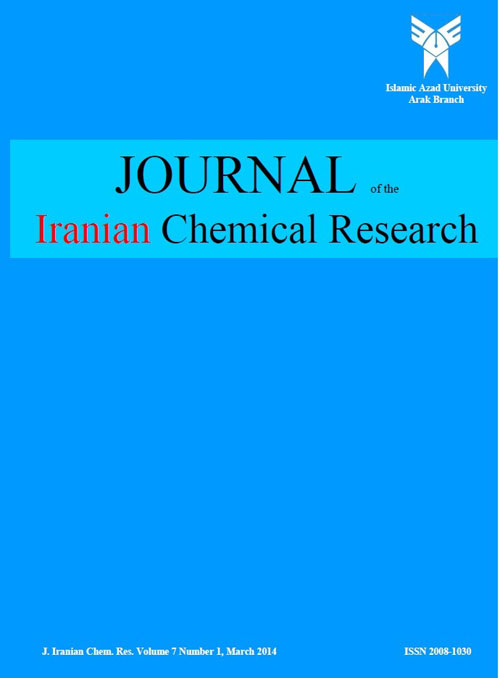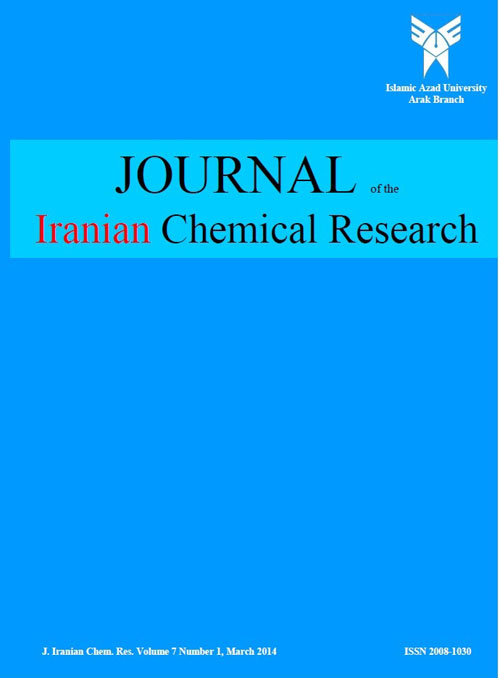فهرست مطالب

Journal of the Iranian Chemical Research
Volume:4 Issue: 4, Autumn 2011
- تاریخ انتشار: 1390/09/30
- تعداد عناوین: 10
-
Pages 207-217Hybrid-density functional theory (B3LYP/Def2-TZVPP) based method and NBO interpretation were used to investigate the conformational behavior of 1,2-dihalodisilanes [halo=F (1), Cl (2), Br (3), I (4)]. The B3LYP/Def2-TZVPP results showed that the anti conformations of compounds 1-4 are more stable than their corresponding gauche conformations. The stability of the anti conformation compared to the gauche conformation increases from compound 1 to compound 4. The NBO analysis of donor-acceptor interactions showed that the generalized anomeric effect (GAE) is in favor of the gauche conformations of compounds 1 and 2. Contrary to compounds 1 and 2, GAE is in favor of the anti conformations of compounds 3 and 4. The GAE values calculated (i.e. GAEanti-GAEgauche) increase from compound 1 to compound 4. On the other hand, the calculated dipole moment values for the gauche conformations increase from compound 1 to compound 3 but decreases from compound 3 to compound 4. Based on the results obtained, there is no conflict between the GAE and the electrostatic model impacts on the conformational preferences in compounds 1-3 but the electrostatic model can not rationalize the increase of the instability of the gauche conformation of compound 4 compared to its anti conformation on going from compound 3 to compound 4. Consequently, in the conflict between the GAE and the electrostatic model, the former succeeded in accounting for the increase of the anti conformation stability from compound 1 to compound 4. There is a direct correlation between the calculated GAE, Δ[rSi-Si(G)-rSi-Si(A)] parameters. The correlations between the GAE, bond orders, ΔGAnti-Gauche, ΔG(Gauche→Gauche′, C2v), ΔG(Anti→Gauche, C2), dipole-dipole interactions, structural parameters and conformational behaviors of compounds 1-4 have been investigated.Keywords: Generalized Anomeric Effects, Stereoelectronic interactions, Ab initio, NBO, 1, 2, dihalodisilanes
-
Pages 219-226In this study, mesoporous MCM-41 has been modified by incorporation of aluminum ion as a rapid, simple and inexpensive method for modification. The adsorbent is characterized using powder X-ray diffraction and nitrogen adsorption-desorption isotherm data. The distribution coefficient of cadmium ion on the mesoporous aluminosilicates has been enhanced with the increase of the aluminum in the framework of the adsorbent. Adsorption behavior of cadmium on the Al10MCM-41 and Al20MCM-41 adsorbents has been studied and experimental adsorption isotherm is successfully described by Langmuir model. The maximum adsorption cadmium capacity was 11.5 mg g-1. The effects of pH and adsorption kinetics have also been studied by batch method and the result shows pH of solution hasnt any effect on cadmium adsorption.Keywords: Mesoporous, Aluminosilicate, Adsorption behavior, cadmium
-
Pages 227-233A cloud point extraction process using the nonionic surfactant Triton X-114 to extract uranium from aqueous solutions was investigated. The method is based on the complexation reaction of uranium with Arsenazo III and micelle-mediated extraction of the complex. The optimal extraction and reaction conditions (e.g., pH, reagent concentration, effect of time) were studied, and the analytical characteristics of the method (e.g., limit of detection, linear range) were obtained. Linearity was obeyed in the range of 1.0-150.0 ng mL-1 of U(IV) ion. The detection limit of the method was 0.3 ng mL-1 of uranium ion. The interference effect of some anions and cations was also tested. The method was applied to the determination of uranium in water samples.Keywords: Uranium, Cloud point extraction, Spectrophotometric, Determination, Triton X, 114
-
Pages 235-249A series of 42 Pyrazolo[4,3-h]quinazoline-3-carboxamides as multi-cyclin-dependent kinase inhibitors regarded as promising antitumor agents to complement the existing therapies, was subjected to a three-dimensional quantitative activity relationship (3D QSAR). Different QSAR methods, comparative molecular field analysis (CoMFA), CoMFA region focusing, and comparative molecular similarity indices analysis (CoMSIA), were compared. All these QSARbased models had good statistical parameters and yielded q2 values of 0.717, 0.806, and 0.557, respectively. The CoMFA region focusing model provided the highest q2 and r2 values, which implied the significance of correlation of steric and electrostatic fields with biological activities. The quality of CoMSIA was slightly lower than that of CoMFA region focusing in terms of q2 and r2 values. The results of 3D contour maps can be useful for the future development of CDKs inhibitors. The results of 3D QSAR models are in agreement with docking results, and the statistical parameters of the models explain that the data are well fitted and have high predictive ability.Keywords: CoMFA, CoMFA region focusing, CoMSIA, CDOCKER, multi, cyclin, dependent kinase Inhibitors
-
Pages 251-262A simple, accurate and precise HPTLC- densitometry method for the simultaneous determination of abacavir, lamivudine and zidovudine in pharmaceutical tablet has been developed. Separation of tablet components was performed on aluminum backed HPTLC plates (silica gel 60 F254 20×20 cm with 0.2 mm thickness, Camag, Muttenz, Switzerland ) using methanol : chloroform : acetonitrile (4 : 8 : 3 v/v). Good sensitivity for all analytes was observed with UV detection at 275 nm. The method was validated for linearity, accuracy, precision, specificity and robustness. The method allowed quantitation over the 2001450 ng/band range for the three components. Both linear and second order polynomial relationships were studied. Second order polynomial fit was found to be more suitable and its residuals plot showed a much better fitting than that of linear model, indicating good correlation and determinations (r = 0.99995, 0.9998 and 0.9998 and r2 = 0.9999, 0.9997 and 0.9996 for 3-TC, ABC and AZT, respectively). The method has an accuracy of 99.35, 99.19 and 99.13 % for 3-TC, ABC and AZT respectively. The method is robust and has the potential to determine these drug substances simultaneously from the dosage forms.Keywords: HPTLC, Abacavir, Lamivudine, Zidovudine, Densitometry, Simultaneous, Determination
-
Pages 263-279A new Schiff base ligand (L) obtained by the condensation reaction of N-acetylaceto-otoluidine and 2-aminopropanoic acid (an amino acid), is used to synthesize four mononuclear complexes of [MLCl] and [ML2] types (where M = Cu(II) and Zn(II); L = Schiff base) by keeping the metal and ligand ratio as 1:1 and 1:2 respectively. This ligand and its complexes have been characterized on the basis of different spectral methods. EPR, UV-Vis. and magnetic moment data afford a square-planar geometry for the [MLCl] complexes and octahedral geometry for the [ML2] complexes. The observed low molar conductivity of these complexes at room temperature is consistent with their non-electrolytic nature. All the complexes display significant oxidative cleavage of circular plasmid pBR322 DNA in the presence of hydrogen peroxide. UV spectroscopic titration with CT DNA reveals that the complexes can bind to CT DNA and the binding constants to CT DNA have been calculated. The cyclic voltammograms of the complexes in the presence of CT DNA reveal that they bind to CT DNA probably by the intercalative binding mode. The antimicrobial activity of the complexes has been tested against microorganisms showing that they exhibit higher activity than free Schiff base ligand.Keywords: DNA binding, Antimicrobial activity, 2, aminopropanoic acid, Schiff base complexes
-
Pages 281-286Sawdust which is the main waste from wood industry has been used as a raw material for removal of Brilliant Cresyl Blue toxic dye. The effects of various parameters such as pH, electrolyte concentration, adsorbent dose, contact time and agitation rate were studied for the removal of the dye in a concentration of 50 mg L-1. The optimum condition for the studied parameters was applied for various concentrations of the dye (20200 mg L-1) and in all the cases an efficiency of more than 96% is attainable. Adsorption isotherms were studied which were well in line with both Langmuire and Freundlich equations. The method was applied for the removal of dye from real samples of different waters such as industrial water, river water, tap water and sea water samples, in all of which dye removal was more than 94.Keywords: Sawdust, Adsorption, Langmuire isotherm, Brilliant Cresyl Blue
-
Pages 287-290An important property that has been extensively studied in quantitative structure activity relationship (QSAR) is the chromatographic retention index. QSAR study is suggested for the prediction of retention index of alkanes and alkenes compounds. Modeling of the retention index of alkanes and alkenes compounds as a function of molecular structures was established by different chemometrics methods. These models were applied for the prediction of the retention index of these compounds, which were not in the modeling procedure. In the present study, the PLS and LS-SVM methods were applied in QSAR for modeling the relationship between the retention index 179 alkanes and alkenes compounds by using structural molecular descriptors.Keywords: QSAR, Retention index, Alkane, Alkene, PLS, LS, SVM
-
Pages 291-300A study of the kinetic analysis of total lead from spent Car battery ash by hydrochloric acid leaching has been examined. The physico-chemical analysis of the ash powder was carried out by the Inductively Coupled Plasma-Mass Spectrometry (ICP-MS) and Xray diffraction (XRD).
The effects of the acid concentration, temperature and particle size on the rate of battery ash dissolution have been investigated. The dissolution rate increased with hydrochloric acid concentration and temperature with decreasing particle size. The kinetic study indicated that the dissolution of total lead could be represented by a shrinking core model with product layer diffusion control mechanism at lower temperatures and a surface chemical reaction controlled mechanism at higher temperatures. The activation energy, Ea and reaction order of 44.13 kJ/mol and 1.14 were obtained, respectively for the dissolution process under the following established
conditions: solid/liquid ratio = 10 g/L, HCl concentration = 4M, temperature= 80 °C, Stirring speed = 300 rpm, Particle size = 0.0500.063 mm for 120 minutes.Keywords: lead, kinetic analysis, spent battery, leaching, hydrochloric acid -
Pages 301-308In this paper, the photochemical degradation of azure-b by Cu2ﴭ 2− process has been presented. Cu2 as photocatalyst and S2O8 2− ion as photooxidant used in this process. At extremely low concentrations, cupric ion showed true catalytic activity in the overall process. The influence of various parameters on the performance of the treatment process has been considered, such as pH, concentration of peroxydisulphate ion (S2O8 2−), concentration of Cu2 ion, concentration of methylene blue and effect of light intensity etc. were observed. The progress of the photochemical oxidation was monitored spectrophotometrically. The results showed that the dye was completely oxidized and maximum decolorization efficiency was achieved at the optimum conditions of the reaction time 120 min. The optimum conditions of initial dye, Cu2 ion, initial peroxydisulphate ion (S2O8 2−) concentration for photooxidation were determined to be 2.8 × 10−5, 4.1 × 10−4 and 3.6 × 10−4 M, respectively and light intensity 62.9 mWcm2−. The value for the reaction rate constants have been determined and found to be 3.20 × 10−4 s−1. Overall photochemical oxidation of methylene blue was observed to follow first-order kinetics. A suitable tentative mechanism for photochemical oxidation of methylene blue has been proposed.Keywords: Photochemical oxidation, Cupric ion(Cu2+), Peroxydisulphate ion(S2O8 2?), Azure, b


